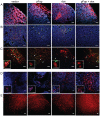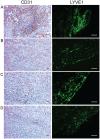Cancer associated fibroblasts promote tumor growth and metastasis by modulating the tumor immune microenvironment in a 4T1 murine breast cancer model
- PMID: 19956757
- PMCID: PMC2775953
- DOI: 10.1371/journal.pone.0007965
Cancer associated fibroblasts promote tumor growth and metastasis by modulating the tumor immune microenvironment in a 4T1 murine breast cancer model
Abstract
Background: Local inflammation associated with solid tumors commonly results from factors released by tumor cells and the tumor stroma, and promotes tumor progression. Cancer associated fibroblasts comprise a majority of the cells found in tumor stroma and are appealing targets for cancer therapy. Here, our aim was to determine the efficacy of targeting cancer associated fibroblasts for the treatment of metastatic breast cancer.
Methodology/principal findings: We demonstrate that cancer associated fibroblasts are key modulators of immune polarization in the tumor microenvironment of a 4T1 murine model of metastatic breast cancer. Elimination of cancer associated fibroblasts in vivo by a DNA vaccine targeted to fibroblast activation protein results in a shift of the immune microenvironment from a Th2 to Th1 polarization. This shift is characterized by increased protein expression of IL-2 and IL-7, suppressed recruitment of tumor-associated macrophages, myeloid derived suppressor cells, T regulatory cells, and decreased tumor angiogenesis and lymphangiogenesis. Additionally, the vaccine improved anti-metastatic effects of doxorubicin chemotherapy and enhanced suppression of IL-6 and IL-4 protein expression while increasing recruitment of dendritic cells and CD8(+) T cells. Treatment with the combination therapy also reduced tumor-associated Vegf, Pdgfc, and GM-CSF mRNA and protein expression.
Conclusions/significance: Our findings demonstrate that cancer associated fibroblasts promote tumor growth and metastasis through their role as key modulators of immune polarization in the tumor microenvironment and are valid targets for therapy of metastatic breast cancer.
Conflict of interest statement
Figures






Similar articles
-
Cancer Cell-Derived Granulocyte-Macrophage Colony-Stimulating Factor Is Dispensable for the Progression of 4T1 Murine Breast Cancer.Int J Mol Sci. 2019 Dec 16;20(24):6342. doi: 10.3390/ijms20246342. Int J Mol Sci. 2019. PMID: 31888216 Free PMC article.
-
Efficacy of herpes simplex virus thymidine kinase in combination with cytokine gene therapy in an experimental metastatic breast cancer model.Cancer Gene Ther. 2000 Jul;7(7):1086-99. doi: 10.1038/sj.cgt.7700215. Cancer Gene Ther. 2000. PMID: 10917212
-
Crosstalk between Cancer Cells and Fibroblasts for the Production of Monocyte Chemoattractant Protein-1 in the Murine 4T1 Breast Cancer.Curr Issues Mol Biol. 2021 Oct 22;43(3):1726-1740. doi: 10.3390/cimb43030122. Curr Issues Mol Biol. 2021. PMID: 34698088 Free PMC article.
-
Therapeutic gene modified cell based cancer vaccines.Gene. 2013 Aug 10;525(2):200-7. doi: 10.1016/j.gene.2013.03.056. Epub 2013 Apr 6. Gene. 2013. PMID: 23566846 Review.
-
Role of the tumor microenvironment in the lymphatic metastasis of cervical cancer (Review).Exp Ther Med. 2023 Sep 1;26(4):486. doi: 10.3892/etm.2023.12185. eCollection 2023 Oct. Exp Ther Med. 2023. PMID: 37753293 Free PMC article. Review.
Cited by
-
Spine and scapular pain: an unusual presentation of colon adenocarcinoma.BMJ Case Rep. 2013 Jul 16;2013:bcr2013010239. doi: 10.1136/bcr-2013-010239. BMJ Case Rep. 2013. PMID: 23861273 Free PMC article.
-
Cancer-Associated Fibroblasts: Accomplices in the Tumor Immune Evasion.Cancers (Basel). 2020 Oct 14;12(10):2969. doi: 10.3390/cancers12102969. Cancers (Basel). 2020. PMID: 33066357 Free PMC article. Review.
-
Cancer-Associated Fibroblasts as Players in Cancer Development and Progression and Their Role in Targeted Radionuclide Imaging and Therapy.Cancers (Basel). 2021 Mar 4;13(5):1100. doi: 10.3390/cancers13051100. Cancers (Basel). 2021. PMID: 33806468 Free PMC article. Review.
-
Int6 reduction activates stromal fibroblasts to enhance transforming activity in breast epithelial cells.Cell Biosci. 2015 Mar 8;5:10. doi: 10.1186/s13578-015-0001-6. eCollection 2015. Cell Biosci. 2015. PMID: 25774287 Free PMC article.
-
In Vitro Suppression of T Cell Proliferation Is a Conserved Function of Primary and Immortalized Human Cancer-Associated Fibroblasts.Int J Mol Sci. 2021 Feb 12;22(4):1827. doi: 10.3390/ijms22041827. Int J Mol Sci. 2021. PMID: 33673197 Free PMC article.
References
-
- Colotta F, Allavena P, Sica A, Garlanda C, Mantovani A. Cancer-related inflammation, the seventh hallmark of cancer: links to genetic instability. Carcinogenesis. 2009;30:1073–1081. - PubMed
-
- Dvorak HF. Tumors: wounds that do not heal. Similarities between tumor stroma generation and wound healing. N Engl J Med. 1986;315:1650–1659. - PubMed
Publication types
MeSH terms
Substances
Grants and funding
LinkOut - more resources
Full Text Sources
Other Literature Sources
Research Materials

